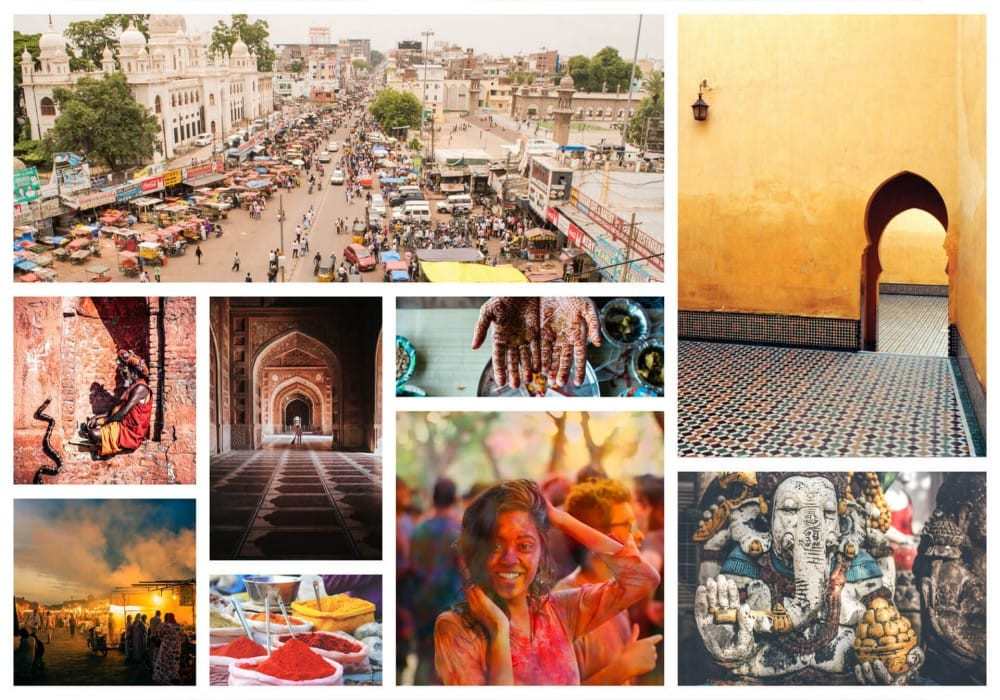
Last Updated At: 07-Jul-2025
Food of Montenegro - Traditional Dishes & Local Flavors
Montenegro, a small country in the Balkans, boasts a diverse and delicious traditional cuisine that reflects its rich cultural heritage. From the coastal region's garlicky seafood to the hearty mountain fare of the interior, the food of Montenegro offers a wide range of delectable flavours. Some must-try dishes include Njegusi Prosciutto, Montenegrin Lamb in Milk, and Black Risotto, a coastal speciality made with cuttlefish ink. The country's traditional cuisine is a delightful fusion of Mediterranean and Central European flavours, making it a unique and enticing destination for food enthusiasts.
In addition to its mouth-watering dishes, Montenegro is known for its vibrant food festivals celebrating the country's culinary heritage. The annual Wine Festival, for instance, is a testament to the importance of wine in Montenegrin culture, where locals and tourists come together to enjoy the finest local wines and traditional holiday dishes. The festivals are not just about the food but also about the human connections and stories behind them, offering visitors a chance to immerse themselves in the warmth and togetherness of Montenegrin culture. So, if you want to experience a rich culinary legacy and savour delicious, traditional dishes, Montenegro is the place to visit!
List of 15 Famous Foods of Montenegro
Montenegro's cuisine offers a delightful journey through its rich flavours and diverse dishes. Traditional Montenegrin cuisine provides a unique taste of the Balkans, from savoury meats to sweet pastries. This guide introduces you to the best local food in Montenegro, highlighting Montenegro food and recipes.
- Njeguši: Savory Smoked Ham from Njeguši
- Kapama: Flavorful Bulgarian Stew, Kapama Style
- Ćevapčići: Traditional Balkan Grilled Sausages, Ćevapčići
- Popovac: Hearty Serbian Beef Dish, Popovac
- Priganice: Delightful Montenegrin Doughnuts, Priganice
- Palačinke: Thin, Versatile Balkan Pancakes, Palačinke
- Kolač: Sweet, Traditional Balkan Cake, Kolač
- Burek: Crispy Filo Pastry, Burek, with Various Fillings
- Lukanac: Spiced Balkan Sausage, Lukanac
- Kraljeva Riblica: Royal Delight of Kraljeva Riblica Fish
- Jagnjeći Pečen: Succulent Roasted Lamb, Jagnjeći Pečen
- Rastani: Simple yet Tasty Balkan Vegetable Dish, Rastani
- Mućkalica: Rich, Spicy Balkan Meat Stew, Mućkalica
- Krpice: Traditional Pasta with Cabbage, Krpice
- Baklava: Sweet, Layered Pastry Delight, Baklava
1. Njeguši: Savory Smoked Ham from Njeguši
Njeguši ham, a traditional Montenegrin cuisine speciality, is celebrated for its unique flavour. Made in the village of Njeguši, this smoked ham undergoes a meticulous curing and smoking process using traditional techniques. The result is a savoury, richly flavoured ham that is a staple in Montenegrin culinary experiences. Njeguši ham is often savoured in thin slices, enjoyed on its own or as part of various Montenegrin dishes. It is a must-try for visitors seeking authentic Montenegro dishes, representing the best local food in Montenegro.
2. Kapama: Flavorful Bulgarian Stew, Kapama Style
Kapama, a Bulgarian stew that has found a special place in Montenegro food and recipes, is a complex and hearty dish. It combines various meats like chicken, pork, and veal, cooked slowly with sauerkraut, wine, and an array of spices. This stew is a winter favourite, offering a warming, multi-layered flavour profile that captures the essence of traditional Montenegrin cuisine. Kapama is a fine example of the Balkan region's culinary richness and is regarded as one of the seafood delicacies Montenegro has incorporated into its diverse food culture.
3. Ćevapčići: Traditional Balkan Grilled Sausages, Ćevapčići
Ćevapčići, a beloved dish in traditional Montenegrin cuisine, consists of small, grilled ground meat sausages. These sausages, made from pork, beef, and lamb, are seasoned with garlic, paprika, and other spices. Ćevapčići is typically served with flatbread, onions, and a yoghurt-based sauce, offering a simple yet delicious meal. They are a popular street food staple in Montenegrin culinary experiences, reflecting the region's love for grilled meats and representing some of the best local food in Montenegro.
4. Popovac: Hearty Serbian Beef Dish, Popovac
Popovac, a hearty Serbian beef dish, has become integral to Montenegro food and recipes. This dish features slow-cooked beef simmered in a rich sauce with onions, carrots, and potatoes, creating a tender and flavorful meal. Popovac is often enjoyed during colder months, providing warmth and comfort. Its deep, meaty flavour and satisfying nature make it a favourite among those seeking authentic dishes of Montenegro, showcasing the influence of neighbouring cuisines on traditional Montenegrin cuisine.
5. Priganice: Delightful Montenegrin Doughnuts, Priganice
Priganice, delightful little doughnuts, are a sweet staple in Montenegrin cuisine. These small, fried dough balls are light and fluffy, often served with honey, jam, or cheese. Priganice is a traditional treat, especially during festivities and family gatherings. They embody the simple yet delicious aspect of Montenegrin culinary experiences, offering a glimpse into the country's sweet treats. As a popular dessert, Priganice is a charming representation of the best local food in Montenegro.
6. Palačinke: Thin, Versatile Balkan Pancakes, Palačinke
Palačinke, thin Balkan pancakes, are a versatile and beloved part of Montenegro food and recipes. Like French crêpes, these pancakes can be filled with sweet fillings like jam or chocolate or savoury options like cheese and ham. Palačinke is popular as a breakfast dish, dessert, or snack, showcasing the adaptability of traditional Montenegrin cuisine. They offer a delightful culinary experience, representing Montenegrin culinary delights' simplicity and creativity.
7. Kolač: Sweet, Traditional Balkan Cake, Kolač
Kolač, a traditional Balkan cake, is a staple in Montenegrin cuisine, known for its sweet and comforting taste. This cake comes in various forms, from simple sponge cakes to ones filled with fruits or nuts. Kolač is often a centrepiece at celebrations and family gatherings, symbolising hospitality and warmth. As a beloved dessert, it represents the rich pastry tradition of Montenegro, making it an essential part of the authentic dishes of Montenegro.
8. Burek: Crispy Filo Pastry, Burek, with Various Fillings
Burek, a crispy filo pastry with various fillings, is a popular dish in Montenegro. Originally from the Ottoman Empire, Burek has become a beloved part of traditional Montenegrin cuisine. It can be filled with cheese, meat, spinach, or potatoes, offering a savoury and satisfying meal or snack. Burek's versatility and delicious taste have made it a staple in Montenegrin culinary experiences, enjoyed at any time of the day.
9. Lukanac: Spiced Balkan Sausage, Lukanac
Lukanac, a spiced Balkan sausage, is a flavorful addition to Montenegro's culinary landscape. Made from a mix of ground meat and a blend of regional spices, Lukanac is often grilled or fried. It's a common feature in traditional Montenegrin barbecues and family meals. This sausage is a testament to the region's love for hearty, spiced meats and is a popular choice for those exploring the best local food in Montenegro.
10. Kraljeva Riblica: Royal Delight of Kraljeva Riblica Fish
Kraljeva Riblica, a fish dish, is a delicacy in Montenegro, especially along the Adriatic coast. Known for its delicate flavour and tender texture, this dish often features freshly caught fish cooked simply with herbs and olive oil. Kraljeva Riblica showcases the seafood delicacies Montenegro is renowned for, offering a taste of the Mediterranean in traditional Montenegrin cuisine.
11. Jagnjeći Pečen: Succulent Roasted Lamb, Jagnjeći Pečen
Jagnjeći Pečen, the succulent roasted lamb, is a cherished dish in Montenegro, especially during special occasions and holidays. The lamb is seasoned with local herbs and slow-roasted to perfection, resulting in tender, flavorful meat. This dish embodies the hearty and festive spirit of Montenegrin culinary experiences, representing a significant part of the authentic dishes of Montenegro.
12. Rastani: Simple yet Tasty Balkan Vegetable Dish, Rastani
Rastani, a simple yet tasty Balkan vegetable dish, is a healthy and flavorful part of Montenegro's cuisine. Made with seasonal vegetables, often bell peppers, tomatoes, and onions, Rastani is light and satisfying. This dish reflects the Mediterranean influence on Montenegrin cuisine, offering a vegetarian option among the traditional Montenegrin food.
13. Mućkalica: Rich, Spicy Balkan Meat Stew, Mućkalica
Mućkalica, a rich and spicy Balkan meat stew, is a hearty and flavorful dish in Montenegro. This stew, combining various types of meat with peppers, onions, and a blend of spices, is a favourite in local taverns and homes. Mućkalica exemplifies Montenegrin culinary delights' robust and spicy side, offering a warming and satisfying meal.
14. Krpice: Traditional Pasta with Cabbage, Krpice
Krpice, a traditional pasta dish with cabbage, is a comforting and homely meal in Montenegro. This simple dish combines pasta with sautéed cabbage and sometimes bacon, offering a tasty and easy-to-make meal. Krpice is a perfect example of the simplicity and heartiness found in traditional Montenegrin cuisine.
15. Baklava: Sweet, Layered Pastry Delight, Baklava
Baklava, a sweet layered pastry, is a beloved dessert in Montenegro. Baklava is a rich and decadent treat made with thin layers of filo pastry, filled with chopped nuts and sweetened with syrup or honey. This dessert is a part of the Ottoman culinary legacy in Montenegro, showcasing the region's rich history in its culinary traditions.
The culinary landscape of Montenegro is as diverse as it is flavorful, offering a rich array of traditional dishes that capture the essence of the Balkans. From the savoury smoked ham of Njeguši to the sweet layers of Baklava, Montenegrin cuisine provides a delightful experience for every palate. Whether a hearty stew or light pastry, each dish tells a story of cultural influences and culinary artistry.
Plan your trip with Adotrip today. Enjoy a wealth of information and end-to-end travel assistance, and book flights, hotels, and tour packages under one roof. With Adotrip, nothing is far!
Frequently Asked Questions about the Food of Montenegro
Q1: What are some traditional dishes in Montenegro?
A1: Traditional dishes in Montenegro include Njeguši (smoked ham), Ćevapčići (grilled meat sausages), Pljeskavica (spiced meat patty), Jagnjeći Pečen (roasted lamb), and Priganice (Montenegrin doughnuts). These dishes reflect the rich culinary heritage of the region.
Q2: Is Montenegrin cuisine influenced by its neighbouring countries?
A2: Yes, Montenegrin cuisine is influenced by neighbouring countries, particularly Italy, Turkey, and the Balkan region. This influence is evident in the use of spices, cooking techniques, and types of dishes, creating a unique blend of Mediterranean and Eastern European flavours.
Q3: Can you tell me about any popular seafood dishes in Montenegro?
A3: Popular seafood dishes in Montenegro include Crni Rižot (black risotto made with squid ink), grilled Adriatic fish (like sea bass and bream), and Jadranska Salata (Adriatic seafood salad). The country's Adriatic coast provides a rich variety of fresh seafood used in these dishes.
Q4: Are there vegetarian or vegan options available in Montenegrin cuisine?
A4: Yes, vegetarian and vegan options are available in Montenegrin cuisine. Dishes like Pita Zeljanica (spinach pie), Ajvar (red pepper relish), and various fresh salads offer delicious plant-based options. Montenegrin cuisine also includes an array of dairy and vegetable-based dishes.
Q5: What is the significance of homemade rakija in Montenegro's culinary culture?
A5: Homemade rakija, a type of fruit brandy, is significant in Montenegro's culinary culture. It's not just a drink but a symbol of hospitality and tradition. Often homemade from grapes or plums, rakija is served to guests as a welcoming gesture and is a staple at celebrations and family gatherings.
--- Published By Adotrip
Latest Blogs

Cash in the Wild: My Safari Adventure Across Kenya with Only...

One Day Picnic Spot Near Pune - Adventure, Trekking and Natu...

One Day Picnic Spots Near Mumbai - Monsoon, Adventure, Beach...

The Best Places to Go in Thailand in 2025










 Dubai
Dubai Malaysia
Malaysia USA
USA





